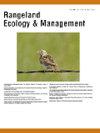Selectivity Strategy and Forage Plant Use by Dromedaries in Saharan Rangeland in the Region of Ouargla (Algeria)
IF 2.4
3区 环境科学与生态学
Q2 ECOLOGY
引用次数: 0
Abstract
The aim of this study was to monitor the grazing and utilization of feed resources by dromedary camels in the Saharan rangelands around Ouargla Algeria, and to illustrate how camels contribute to the maintenance and improvement of their environment despite the limited vegetation. The research methodology employed the tooth strikes method, involving direct observation of biting. In this study, a camcorder was used for the first time as a means to record camel activity on the range, aiming to prevent any loss of information. Recording sessions of 1 hour each were conducted in the morning and afternoon for each female camel, under conditions of decreasing vegetation availability during each season. The monitoring results revealed that dromedaries exhibit a distinct attitude toward plants. They allow the regeneration of less abundant species by taking small bites while consuming more extensively from the more abundant species. Statistical analysis demonstrated a highly significant relationship between species abundance and grazing probability (P < 0.001). According to the “Chi-squared Automatic Interaction Detector” method, species with an abundance exceeding 13% have a sampling probability with a precision of 76.8%. In contrast, species with an abundance between 6% and 13% have a 45% probability of grazing, while those with an occurrence rate of 6% have a 7% probability of grazing. Likewise, the analysis of variance test indicated a highly significant relationship between plant height and grazing time (P < 0.000). Consequently, the number of plant parts consumed was found to be proportional to the plant’s height. The camel’s behavior toward its environment facilitates the regeneration and preservation of plant cover in its pastures.
阿尔及利亚瓦尔格拉地区撒哈拉草原单峰骆驼的选择策略及牧草利用
本研究的目的是监测阿尔及利亚瓦尔格拉周围撒哈拉草原上单峰骆驼对饲料资源的放牧和利用情况,并说明在植被有限的情况下,骆驼如何为维持和改善其环境做出贡献。研究方法采用牙齿撞击法,包括直接观察咬合。在本研究中,首次使用摄像机作为记录骆驼活动的手段,以防止信息丢失。在每个季节植被可用性减少的条件下,对每只母骆驼分别在上午和下午进行1小时的记录。监测结果显示,单峰骆驼对植物表现出明显的态度。它们通过咬一小口,同时更广泛地消耗更丰富的物种,从而使较少的物种再生。统计分析表明,物种丰度与放牧概率呈极显著相关(P <; 0.001)。根据“卡方自动相互作用检测器”方法,丰度超过13%的物种的采样概率为76.8%。相比之下,丰度在6%至13%之间的物种有45%的放牧概率,而发生率为6%的物种有7%的放牧概率。同样,方差检验分析表明,株高与放牧时间呈极显著相关(P <; 0.000)。因此,发现消耗的植物部分的数量与植物的高度成正比。骆驼对环境的行为促进了草场植被的更新和保护。
本文章由计算机程序翻译,如有差异,请以英文原文为准。
求助全文
约1分钟内获得全文
求助全文
来源期刊

Rangeland Ecology & Management
农林科学-环境科学
CiteScore
4.60
自引率
13.00%
发文量
87
审稿时长
12-24 weeks
期刊介绍:
Rangeland Ecology & Management publishes all topics-including ecology, management, socioeconomic and policy-pertaining to global rangelands. The journal''s mission is to inform academics, ecosystem managers and policy makers of science-based information to promote sound rangeland stewardship. Author submissions are published in five manuscript categories: original research papers, high-profile forum topics, concept syntheses, as well as research and technical notes.
Rangelands represent approximately 50% of the Earth''s land area and provision multiple ecosystem services for large human populations. This expansive and diverse land area functions as coupled human-ecological systems. Knowledge of both social and biophysical system components and their interactions represent the foundation for informed rangeland stewardship. Rangeland Ecology & Management uniquely integrates information from multiple system components to address current and pending challenges confronting global rangelands.
 求助内容:
求助内容: 应助结果提醒方式:
应助结果提醒方式:


